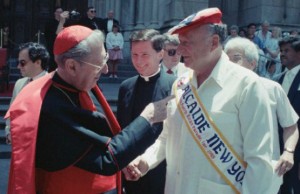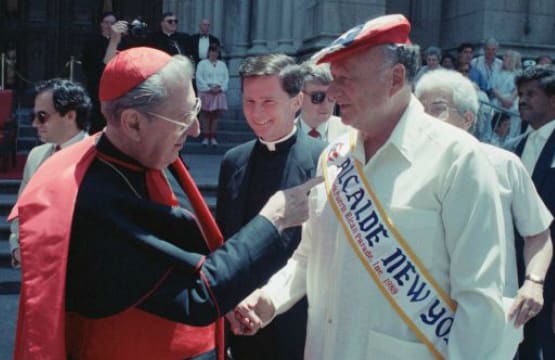
First, Catholic New York reported that the sister of Cardinal John O’Connor, the late archbishop of New York, had recently discovered that their mother was a Jewish woman who had converted to Catholicism at the age of 19. Thus, O’Connor was technically Jewish.
Now, a Dix Hills, L.I., genealogist has found that his mother’s father was a rabbi — in Bridgeport, Conn. It appears he may have also served as the local kosher butcher and perhaps even the shochet, a person trained and licensed to slaughter animals and birds in a manner prescribed by Jewish law.
“And like many of us, he even had an Aunt Minnie,” said the genealogist, Renee Steinig.
Steinig, a former president of the Jewish Genealogy Society of Long Island and a professional genealogist for the last 20 years, came upon the information after reading the story about O’Connor’s mother, Dorothy, and “out of curiosity” decided to look further.
Steinig said Catholic New York reported that O’Connor’s sister, Mary O’Connor Ward, found that their mother’s family had lived in Bridgeport, and that her father’s name was “Gustav Gumple.” So Steinig said she turned to ancestry.com and checked Bridgeport city directories — similar to phone books but containing only addresses of residences and often a person’s occupation.
“I searched for all listings of Gustav Gumple in Bridgeport, but I searched in a way that allowed for spelling variations, which are so common,” she said. “As it turned out, almost all of the records I found spelled the name “Gumpel.”
Asked how she could be sure it was the same person, Steinig replied: “You still have to be cautious, even when a name strikes our ears as unusual and the person lived in a relatively small community.
“The article mentioned that Gustav’s wife’s name was Tina, and I found a family with similar names in the 1880 U.S. census. ‘Gustave and Denna Gumple’ were living on the Lower East Side of New York City with four daughters. … I found ‘Rev. Gustave Gumpel’ listed in an 1882 Manhattan directory. [His wife, Tina, died in 1890.] Gustave, widowed, appeared in the 1900 and 1910 censuses living in Bridgeport. Several of the kids’ names recurred, and some were born in New York, so I suspected that it was the same family.”
Catholic New York said Mary O’Connor Ward and one of her daughters, Eileen Ward Christian — who had encouraged her mother to conduct the search — found that Mary’s mother’s family had immigrated from Prussia.
Steinig said she checked Hamburg emigration records and found a “Tine” Gumpel who came from Inowroclaw, a once Prussian town that is now in Poland, near Poznan. Tine, who may well be the mother of the cardinal’s mother, sailed to New York with five children in February 1880 and arrived in March. She probably joined Gustave here.
Steinig said it was not uncommon for immigrant fathers to come first and send for their families later. Nor was it uncommon for families whose first stop was New York City to stay there initially.
The oldest Gumpel children were listed as 9, 8, and 6 years old, so Steinig said she believes they weren’t born to Tina, who at the time was 21.
“The two youngest children could have been hers,” Steinig added.
Other records revealed that the couple did not stay in New York City very long, because they had a daughter who was born in Connecticut in 1883. Cardinal O’Connor’s mother, Dorothy, was probably born in either 1887 or 1888 — Social Security records list her birthday at August 1888. Steinig said her name was listed on the 1900 census as Dora.
“In my experience, the name Dora was often an English variation of Devorah,” she said.
Bridgeport city directories from 1887 to 1904 listed a “Rev. Gustave Gumpel,” and many referred to him as a “Jewish clergyman,” Steinig said she found. “In 1890 and 1891, directories also listed as his place of business a ‘meat market.’”
That suggests, she said, that he might have served as both the spiritual leader of Congregation B’nai Israel, and as the local butcher. The congregation’s current rabbi, James Prosnit, said it would not have been unusual for the rabbi to hold two jobs and that there was a “relatively sizeable” Jewish population in Bridgeport at that time.
A check of the 1899 American Jewish Year Book listed Rabbi Gustave Gumpel as the spiritual leader of Congregation B’nai Israel in Bridgeport. And Steinig said a history of Bridgeport identified him as the synagogue’s second rabbi.
In the 1910 census, Gustav Gumpel is listed as a “retired minister.”
“The use of the word minister to refer to a rabbi is not unusual,” Steinig said.
Rabbi Prosnit told The Jewish Week that a check of his congregation’s archival records confirmed that Gustave Gumpel was indeed its second rabbi. In fact, Rabbi Gumpel and his wife, along with several of their children, are buried in the congregation’s cemetery plots.
“Our congregation was chartered in 1859 and, according to archival material, it was started by 22 men who were immigrants from Germany,” he said. “Its first rabbi, A. Jacobs, was paid a salary of $20 a month. It was a strictly Orthodox congregation that switched to Reform around 1902.”
But he said that “by the late-19th century many members considered themselves to be Reform Jews, and in 1895 some members of the congregation broke away and established Adath Israel, a synagogue more in keeping with their roots.”
It is unclear how long Rabbi Gumpel remained the congregation’s spiritual leader, Rabbi Prosnit said. All that is certain is that in 1909 the congregation listed Richard Stern as its rabbi.
It is also unclear why Rabbi Gumpel’s daughter Dora — then known as Dorothy — decided in 1908 to be baptized a Catholic at the age of 19, before meeting her husband-to-be, Thomas O’Connor, whom she married in 1909. Dorothy’s daughter Mary told Catholic New York that the research she and her daughter conducted led them to the archives of the Archdiocese of Philadelphia and the marriage record for Dorothy and Thomas O’Connor. It was those documents that revealed that Dorothy had been baptized at Sacred Heart Church in Bridgeport on April 3, 1908.
The cardinal’s sister is quoted as saying that she doesn’t believe her brother knew their mother was born Jewish, and that although she suspected her mother was a convert she never discussed it with her.
Rabbi Joseph Potasnik, executive vice president of the New York Board of Rabbis, noted that O’Connor Ward is a member of his group’s advisory board and “is a major supporter, very pro-Israel and in her brother’s tradition a bridge builder.”
Rabbi Potasnik said Cardinal O’Connor “strengthened the relationship between Jews and Catholics. I remember him standing on the steps of St. Patrick’s Cathedral to watch and give support to a Soviet Jewry march” down Fifth Avenue in 1987.
He noted that it was “not unusual to have him speak at the Board of Rabbis.” In fact, Rabbi Potasnik said, during the installation of Rabbi Marc Schneier, spiritual leader of The Hampton Synagogue, as president of the board in 1998, Cardinal O’Connor took off his red zucchetto or skullcap and presented it to the Rabbi Schneier as a gesture of Catholic-Jewish friendship and understanding.
Steinig, the Jewish genealogist, said further research she conducted on the other children of Rabbi Gumpel revealed that another daughter, Della, also intermarried. And in reading the obituary of another daughter, Regina, who died in 1954, there is a curious omission. It said there were only two surviving siblings — “Mrs. Minnie Cohen and Miss Raye Gumpel” — no mention of her intermarried sisters, Dorothy and Della.
The words of this author reflect his/her own opinions and do not necessarily represent the official position of the Orthodox Union.



